 |
Your path =Home>Beadmaking and Materials>Beadmaking, Glass > Blown Beads
Blown Glass Beads
Blowing (initially from the lungs; more recently mechanically) is used in the making of some drawn and segmented beads. However, blown beads are defined as beads made from tubes in which incoming air helps form one or a series of beads.
We do not know when this process was invented. A story is that a certain M. Jaquin from Passy near Paris realized that fish scales would yield a protein (guanine) that resembled the surface of pearls. In the mid or late 17th century he began making "Roman" pearls by coating the inside of blown glass beads with guanine and inserting wax to hold the guanine and give the pearls some weight. It is unknown if he invented the whole process
or only the guanine extraction. The family continued the work for 200 years.
|
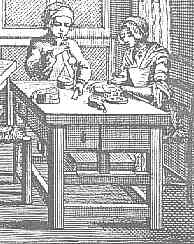
|
Detail from Denis Diederot's Encyclopédie of the late 18th century showing the blowing of "Roman pearls." The woman on the left is expanding a tube into a round ball by heating the tube over a lamp stoked by a bellows beneath the table (Paul Mickey pointed out the bellows to me).
The other woman is heating the ends of the hollow spheres to smooth them after they have been broken from the tube.
(Reprinted in Gillispie 1959: pl. 428)
|
|
|

|
Roman pearls can still sometimes be found, though often in bad shape. Left: wax center and broken exterior of a bead (Donor Angela Froud).
Right: beads showing different sizes of apertures.
|
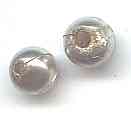
|
|
With blown beads made singly in this way, a common occurrence is that one aperture (opening) will be small and the other one larger.
The large one was apparently at the part of the tube nearest the worker. It was very hard to blow a perfect sphere and a slight "teardrop shape" resulted. When cut from the tube the slightly tapering end gave a larger aperture.
|
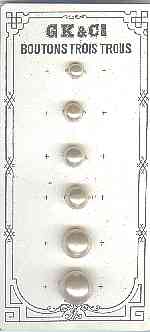
|
Lachau, Germany, had been making glass since 1597. In the early 1800s Hans Greiner developed a way to blow beads and silver them inside. These soon became popular all over Europe and other inventions followed. In 1820 his son George developed a better forge. Under-arm bellows and metal molds were also introduced
In 1845 glassmakers at Jablonec nad Nisou (Czech Republic) also began making hollow beads. Eventually their work surpassed the Lachau beadmakers, who went into eclipse around the beginning of the 20th century (Rogers and Hawkins 1977: 7-8).
Left: sample card from Lauchau, date unknown. The hollow "pearls" are flat on one side and meant to be used as buttons.Donor: Jürgen Busch.
|
|
|
Neuwirth (1995a: 39-52) could not trace the history of the Czech blown bead industry back much further than the last few decades of the 19th century. From that point on, however, it boomed. Many designs and innovations were introduced and the tradition of making elaborate Christmas tree ornaments developed.
Right - Spider Christmas tree ornament made with blown beads and bugles, second quarter of 20th century. (Neuwirth 1995b: card 8).
|

|
|
|
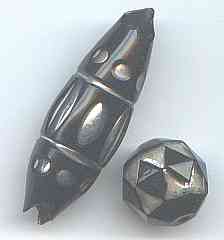
|
Czech blown beads were sometimes spectacular, as are the two at the left. They began as a cased tube, with black over clear glass. Then they were blown into molds and silvered on the inside.
Then the famous local glass grinders went to work, smoothing the ends and adding facets, removing the black layer.
This results in a series of tiny mirrors framed in black glass all over the beads.
|
|
|
The Japanese learned to make blown beads, apparently as a result of Sakubei Oi bringing the technique of single-blowing beads from Europe in 1875. Around 1885 Tokichi Nakamichi introduced a multiple mold-blowing technique. These beads were popular, particularly in Asia (Blair 1973: 293).
Right: mold-blown beads from post WW II Japan. Seams are visible at the edges of the beads.
|
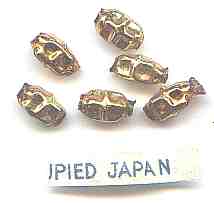
|
|
|
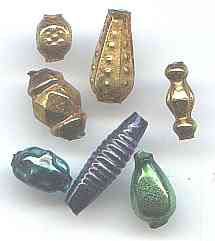
|
Molded blown beads are cheap, light, colorful and popular. The come in a great variety of form and serve many uses. They are used as festival garlands (including Christmas trees), beaded curtains, throwaways at Carnival, etc. They are particular favorites in some villages in Mexico and Peru.
A variety of silver-lined molded blown glass beads.Donor: Angela Froud.
|
|
It is not clear when the art of blowing glass beads came to India or exactly how it was introduced. Blair (1973: 293) said that Sakubei Oi, who brought the industry to Japan from Europe, later managed a bead factory in India. Some pieces in the Center's collection suggest that beads were being blown at least by World War II.
Workers in Firozabad, where this is done, have suggested a date of about 1970. Others have told me that the Japanese made these beads in India before that time and around 1970 the Indians figured out how to do everything on their own.
|
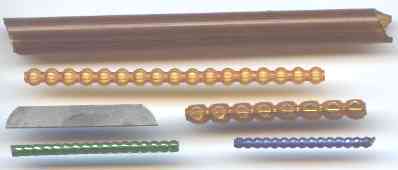
|
|
However the Indians learned to make these beads, they have built a considerable industry. They are particularly popular as imitation gold beads.
Top: a tube used to make blown beads by being heated and put into a mold. Second row: a molded tube, without being silvered. Third row: left, a blade used to cut the beads apart; right: a silvered tube, not yet cut up. Bottom row: silvered green and blue molded tubes.
|
|
|
The Indians may start with a prepared tube (as seen above) and heat it, snapping it into a mold. They also blow a small amount of glass, pull it down, forming a tube and snap a two-part mold around it, using a trigger discharged with their foot, as shown here.
[Sorry about the picture. I haven't located the original; I'll keep looking.]
|
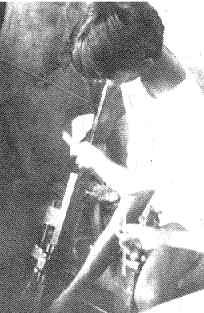
|
|
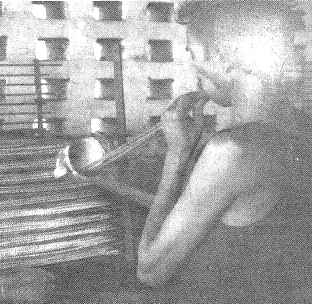
|
To get the silver ammonium nitrate into the tubes to yield the metallic effect, a worker simply sucks it up the molded glass tubes. This dangerous practice was abandoned in Germany-Bohemia a long time ago.
[Ditto for the quality of the picture.]
References for the Indian section: Francis 1982: 9-10.
|
|
REFERENCES:
Blair, Dorothy 1973 A History of Glass In Japan. Kondasha, Tokyo.
Francis, Peter Jr. 1982 The Glass Beads of India. WBMS 7. Lapis Route, Lake Placid. (available here).
Gillispie, Charles Coulston, ed. 1959 A Diderot Pictorial Encyclopedia of Trades and Industry. Dover,
New York.
Neuwirth, Waltraud 1995a Glass Bead Christmas Tree Ornaments/Glasperlen Christbaumschmuk. Privately Printed, Vienna (text and captions in English and German) (available here).
--- 1995b Christmas Tree Ornaments: Glass Beads, Art Postcards 1. Privately printed, Vienna.
Rogers, Maggie and Judith Hawkins 1977 The Glass Christmas Ornament: Old and New. Timber Press, Forest Grove OR.
_________________________________________________
Small Bead Businesses | Beading & Beadwork | Ancient Beads | Trade Beads
Beadmaking & Materials | Bead Uses | Researching Beads | Beads and People
Center for Bead Research | Book Store | Free Store | Bead Bazaar
Shopping Mall | The Bead Auction | Galleries | People | Events
The Bead Site Home | Chat Line | Contact Us | Site Search Engine | FAQ
|
 |










